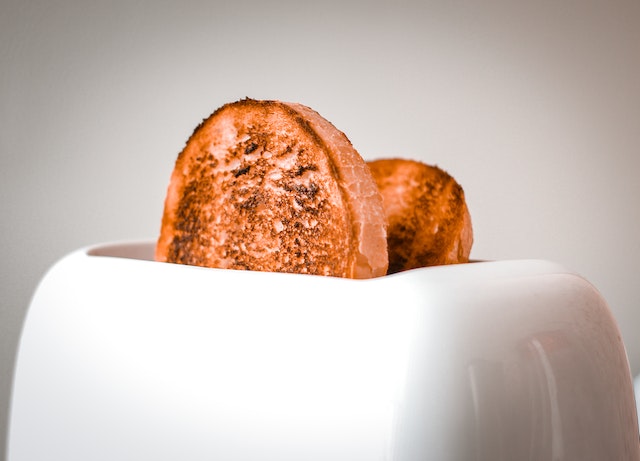
How does the heating element in a toaster work? It is made of a metal that has a high electrical resistance so it heats up very quickly.
The heating element in a toaster is made of nichrome. Nichrome is an alloy made from (usually) 80% nickel and 20% chromium. Hence its name: nickel+ chrom(e)ium. There are four main reasons why nichrome is used in toasters and in other heating elements.
The first reason is that it can withstand high temperatures. Nichrome has a melting point of 1,400°C. A toaster is usually set to heat the bread in a narrow temperature range between 140°C and 160°C. Any more or less than that and the Maillard reaction won’t happen. Nichrome can easily withstand the temperatures required of it in a toaster.
Secondly, when it is heated up, it produces a layer of chromium oxide, which protects the element from oxidation. Early filaments were made of steel, which would slowly become brittle and burn away, needing replacement.
Thirdly, nichrome has a very high electrical resistance, which means it heats up very quickly. If something has a high electrical resistance, electricity has more difficulty flowing through it. The electrons flowing through the material is more likely to hit the atoms in the material and they transfer their kinetic energy to the atom as vibrational energy. When atoms vibrate more, they generate heat. A steel filament would take longer to heat up because it conducts electricity more efficiently. Nichrome heats up very quickly, once an electric current is passed through it, so it is also used in devices like hairdryers.
And, lastly, nichrome is fairly cheap, meaning it can easily be mass produced. Nichrome was invented by Albert Marsh in 1906. Without him, you wouldn’t be able to have your hot, buttery toast, slathered in jam every morning. Well, you would, but it would take a lot longer, and your toaster or grill would be far more expensive.
As an aside, the heating element has to heat the toaster to a specific temperature range because that is the temperature at which the Maillard reaction happens. The Maillard reaction is the reason toast tastes so good. It is a chemical process that was discovered by Louis Camille Maillard in 1912. It happens in many different foods, not just toast. The reaction can happen at room temperature, but it happens fastest at a temperature of between 140 and 165℃.
When the temperature is right, amino acids and simple sugars (carbohydrates) in the food come together and form chains of new molecules. These chains of molecules give the food its new, more delicious taste. They are also responsible for the smell and the color. The chains of molecules reflect the light differently and give it a brown color. They are responsible for the grilled meat flavor you get when you grill a steak.
When you heat something at a high enough temperature, the water evaporates, allowing the heat to penetrate deeper into the food. The Maillard reaction begins when the heat is high enough on the surface of the food. That is why a boiled steak doesn’t go brown but one fried in a pan does. Salting the meat also helps with the Maillard reaction because it draws the water out of the surface of the meat, allowing it to get hotter faster. You need dry heat for the Maillard reaction to happen. When you toast bread, the dry heat of the toaster removes all of the water from the bread, making it less flexible, and speeding up the Maillard reaction.
When you are toasting your bread, though, you need to make sure you don’t grill it for too long because then you will start a process called “pyrolysis”, which basically means you have burned it. And, as I’m sure you have experienced, pyrolysis makes the toast taste bitter, not better.
People have toasted bread in front of fires for as long as people have had bread and fires. There were different ways of cooking bread over a fire or an oven, but it was only in 1905 when Albert Marsh invented Nichrome that the toaster took off. George Schneider used Marsh’s Nichrome to make a heating element and patented the first toaster in 1906. The pop-up toaster was invented in 1921. The toaster really came into its own when pre-sliced bread was invented in 1928.
So, the heating element in a toaster works because electrical resistance heats it up quickly. It then initiates the Maillard reaction, which makes the toast taste so good. And this is what I learned today.
Photo by Photography Maghradze PH: https://www.pexels.com/photo/toasted-bread-3997309/
Sources
https://www.hagley.org/librarynews/history-making-toast
https://en.wikipedia.org/wiki/Heating_element
https://en.wikipedia.org/wiki/Nichrome
https://www.seriouseats.com/what-is-maillard-reaction-cooking-science
